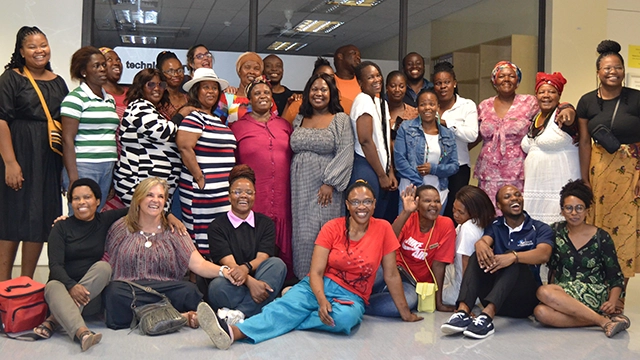
By: Lance Myburgh
In the wake of contemporary digitalisation, the launch of the science and art exhibition by the NRF-SAIAB IMIsEE Project, in collaboration with the Rhodes University Department of Music and Musicology, took the Makhanda community by storm in bridging the gap between community-engaged research, science, music, and art. The Sound Postcard Exhibition Launch promotes digital methods and tools for collaborative research in the Humanities.
The exhibition took place on the 14th of February 2024 at Rhodes University. It included a vibrant exhibition of research art accompanied by music, showcasing the work done by the NRF-SAIAB IMIsEE Project in collaboration with the Rhodes University Department of Music and Musicology. The team comprised scholars collaborating to elucidate the synergies between digitalisation and indigenous knowledge within their community-based research. As a result, contemporary forms of digital tools were utilised to create and foster interdisciplinary collaboration between music, art, and science to enhance innovative and impactful outcomes as exemplified by this project. This made the students' academic research accessible to the community's people through a qualitative research methodology to benefit both the researcher and the subset of participants.
Dr. Allette Schoon kickstarted the event with a warm welcome to all dignitaries, distinguished guests, students, attendees, and staff of Rhodes University. In her welcoming remarks, she underscored the significance of recognising the collective journey undertaken by the team members in curating the exhibition, emphasising the invaluable lessons gleaned from this collaborative endeavour.
Dr. Boudina McConnachie, as Head of Department and Senior Lecturer at Rhodes University specialising in ethnomusicology, declared “historical research has always been available to the academics only. That is not sustainable, as information is taken from the communities to benefit oneself.” Additionally, she stated that this launch serves as a pivotal opportunity for the co-creators of the research to have accessibility to the research. McConnachie emphasised the transformative potential of digitalisation in research and indigenous knowledge systems, noting its capacity to enable widespread access to information compared to the limited reach of traditional newspaper articles.
These sentiments were further exclaimed by Senior Scientist and NRF-rated Researcher Dr Francesca Porri at the South African Institute for Aquatic Biodiversity (SAIAB). She confirmed, "This project used sound and image as a unifying language for all members to define their roles through one image and one sound – this is the link between science and the community, art, and music.” Therefore, democratising access to cultural and scientific content makes it more open to the researched community.
The exhibition garnered significant acclaim, drawing a substantial audience. Some of the scholars’ work included Praise Mathebula, currently pursuing a master’s degree in Music, and Kuhle Ngqezana, serving as an RMR intern and Masters researcher. Both were integrally involved in recording the sounds in the field with the Hamburg community. Vuyelwa Moyo and Thandi Matyobeni made indispensable contributions to the team as data collectors and photographers, curating and documenting the evolution of the Sound Postcard Exhibition.
The unity of music, art, and science enriches a comprehension of the world, inspiring creativity and innovation and fostering collaboration across disciplines. It allows for a holistic approach to knowledge and expression that can lead to profound insights and discoveries. This exhibition launch served as a primary reminder of the power of digitisation in forming a collaborative relationship between academic research and the indigenous knowledge of the Makhanda community. As a result, it is believed that the legacy of this initiative will live on to continue inspiring others and birth a collective of ideas that could promote opportunities for academics to think outside of the box in their research processes.

